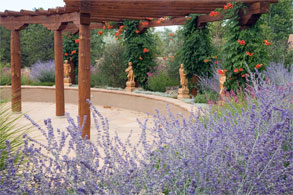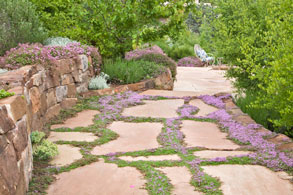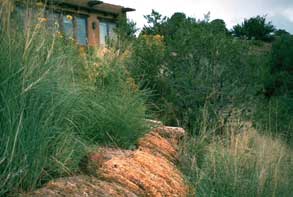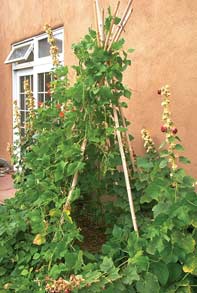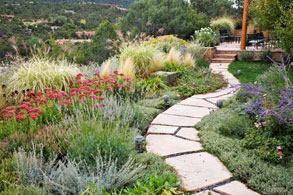When choosing a landscaping company, it is important to find one with a history of providing elegant, cost-effective solutions to the challenges of our climate. By using permaculture principles that work with nature, reduce maintenance costs and increase property values, we create paradise in the desert. At the same time our team prides itself on responding quickly to the needs and desires of our clients. Please contact us for a list of references, to set up a consultation or to receive our brochure in the mail.
Consultation
Our first step in working with a you, a new client, is usually an initial one-hour, on-site landscape consultation. During this time we determine your particular property's basic needs. We listen to the desires and concerns that you express, and we provide a wealth of information and practical ideas concerning your landscape. We also describe our process for designing and installing landscapes that can fit within any reasonable budget and/or time frame. After this initial consultation we put together an estimate for the next phase of the project be it for immediate installation, an on-site design estimate, or a master plan in AutoCAD.
Design
After an initial consultation Santa Fe Permaculture typically provides an estimate for an on-site design or a master plan in AutoCAD. In both cases in order to serve you better, clients are asked to fill out a simple client questionnaire, which we review early in our process.
- An on-site design is an extended consultation with one or more of our designers from our team during which we line out pathways, patios, planting beds, etc. using colored flags. Even though we write plant names on flags using permanent markers, on-site designs lack the permanence of a master plan in AutoCAD. For this reason on-site designs work best when we install them relatively soon after we have finished designing them.
- A master plan in AutoCAD includes a five step design process that culminates in a detailed cost estimate. Since drawings are done on the computer, it is often easy to make changes to the design. One of the many benefits of this type of design is that different phases of the project can be easily installed over a long period of time by simply referring to the large, easy-to-read hard copies we provide.
Beautiful Gardens
Whenever we make a landscape attractive, we achieve our greatest goal: to stimulate the human spirit. We believe that a greater appreciation of nature allows for nature herself to be enriched. The poetry of a place is a difficult thing to describe, but with proper planning and care, any piece of land has the potential to delight, to calm and to inspire.
Fine Stonework
Our designs often feature elegant flagstone patios and attractive rock walls. Perhaps a brick walk undulates with the natural contours of the land or even a simple bark pathway winds casually into the wilderness. Some clients select precisely equal spacing between stones, some prefer a less orderly effect. Whatever the unique situation, we understand that every client has different priorities and particular tastes. We pride ourselves in being able to satisfy these tastes in every circumstance.
Erosion Control
Preventing our clients' land from eroding is always an underlying concern for Santa Fe Permaculture. Often land here in Northern New Mexico is simply too valuable to allow precious real estate to slip away. Sometimes solutions are simple: carefully placed natural materials across an arroyo can effectively control erosion. Other times more elaborate systems involving swales, weirs, straw mats, pumice wicks, wire-wrapped gabions, etc. are necessary. We combine time tested technologies in a wide range of projects with overwhelming success.
Water Harvesting
Using storm run-off from roofs, roads, patios and natural slopes can be easy—and its worth it! Up here in the high desert, rainwater harvesting should be one of the main goals of every landscaping company—not only for environmental reasons, but also for simple economic ones. Our clients profit from healthier, more beautiful plants, lower water bills, fewer erosion problems and reduced maintenance costs (in short: increased property values!). At the same time the local ecology benefits from the increased moisture in the soil, more frequent and longer blooming periods, and faster, more vigorous growth throughout the given property.
Santa Fe Permaculture divides water harvesting into three forms.
- Active water harvesting means precipitation that is harvested in cisterns (water tanks) and is usually then pumped out usually into a drip irrigation system.
- Passive water harvesting means precipitation that is harvested in more natural systems that do not have any moving parts (including swales, bale swales, gabions, French drains, and pumice wicks).
- Waste water recycling means either black or grey water that is safely re-used. Santa Fe Permaculture works with others in the industry who treat black water on-site. In house, we are practitioners of Art Ludwig's grey water re-use system, called the "branched drain system." More information on grey water can be found at oasisdesign.net and New Mexico Environment Department.
We also apply certain techniques like deep pipe irrigation that conserve water and make plants grow faster and stronger.
No matter what your needs, desires and budget constraints are, we can help you be as water-conscious as possible when it comes to your landscape.
Edible Landscaping
Although this is not a major focus for our typical client, once or twice a year a client comes along who is really interested in planting edible plants. These are usually among our favorite projects, because we get to apply the fundamentals of permaculture. At its core permaculture means sustainability.
Whether you occasionally pick fruits from a few low-maintenance perennials, or you harvest fresh food on a daily basis, the ethics and principles of permaculture are clearly at work. By being responsible for at least part of the production of your diet, you demonstrate a care for the earth and a care for people. You recognize that the problem is the solution, because you no longer have the problem of, for example, tasteless tomatoes. You have the solution: red, ripe and juicy ones!
Edible landscaping is an essential part of all permacultures, because permanent cultures are impossible without local food production.
In landscapes where beautiful settings bring people closer to wildlife, where erosion control is being practiced, and where microclimates are being created, the greatest ethical potential of the landscape will never be attained whenever food production is absent.
Edible landscaping produces all of conventional landscaping's beauty plus it always adds more with the smells, flavors and feelings that healthy, fresh food provides.




